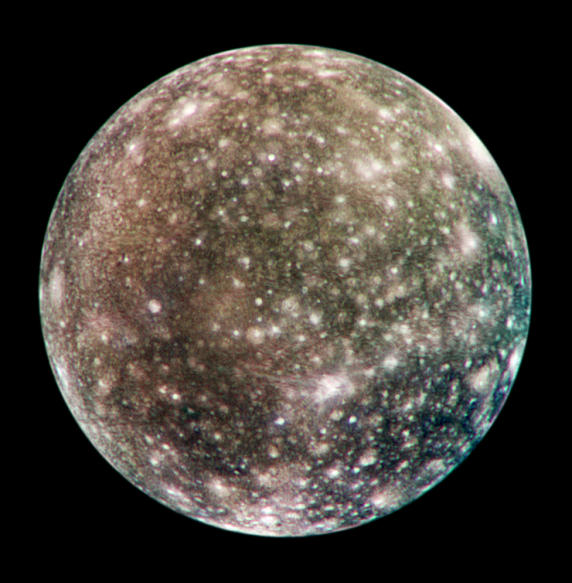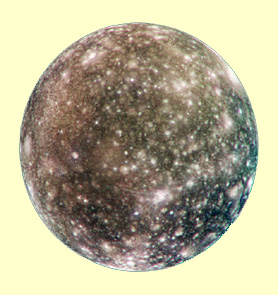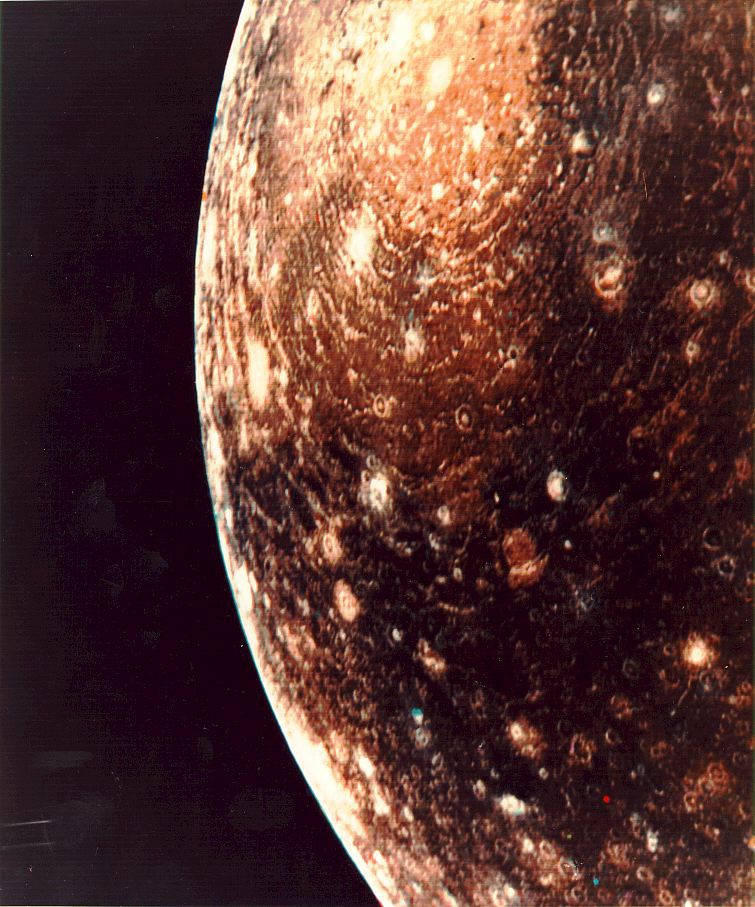Ameen Batah
Callisto
1. Location
2. Discovery
3. Origin of Its Name
4. Size
5. Temperature
6. Structure
7. Orbit
8. Origin of Body
9. Unique Information
10. Relevance to Humans
Did you know that the second largest moon on Jupiter is only a little bit smaller then the planet Mercury? Jupiter's moon Callisto is located about one million eight hundred thirty-three thousand kilometers away from Jupiter, and Jupiter at its closest point is about five hundred eighty-eight million kilometers away from Earth.
Mercury
 VS.
VS.  Callisto
Callisto
Callisto was discovered January 7, 1610 by
Galileo Galilei, thus became one moon in the Galilean Moons.

The origin of this moons name, of course has to do with Greek/Roman
Mythology. The Greek goddess Artemis (Roman name Diana) was a
Virgin/young woman eternally. Callisto was an extremely good looking young woman who was associated with Artemis. She followed all of the rules set down by Artemis and became her favorite woman out of the many she was
Acquainted with. Then Zues/Jupiter noticed Callisto's beauty and decided to get to her through trickery, he transformed into Artemis and Callisto let her guard down. He then seized his oppurtunity with her, and raped her. Soon after she found out she was pregnant and feared this greatly because the vow of
chastity she had made to Artemis. Knowing that Artemis would be ferious, Callisto tried to hide her pregnancy and succeeded for a while. Then one day all of the young women were called together to bathe with Artemis, and when Callisto got naked her secret was clear. Artemis was furious and banished her from all relations that they ever had.
Hera, who hated Callisto took this chance and turned Callisto into a bear. Jupiter then placed her into the Ursa Major constellation, meaning "The Big Bear" which is also home to "The Big Dipper."
 Artemis Banishes Callisto
Artemis Banishes Callisto
Callisto is four thousand eight hundred and six kilometers long in diameter. The Earth's diameter is twevle thousand seven hundred fifty six kilometers. If you were to make an estimate you could say somewhat accurately that Callisto is about one third the size of Earth. For a moon that is quite massive. It is the second largest of Jupiter's moons and the third largest moon in our solar system.

The surface temperature of Callisto is about one hundred and sixty eight (K). If you think Vermont is cold think again, if you went walking on Callisto it would be colder then negative one hundred degrees Celsius. A (K) is a measurement of temperature, it is called a Kelvin degree created so it would be easier to measure the
absolute zero.
| Temperature |
Kelvin
(in degrees)
|
Celsius(in degrees) |
Fahrenheit
(in degrees)
|
| Boiling |
373.15 |
100 |
212 |
| Freezing |
273.15 |
0 |
32
|
The structure on inside and out on Callisto is one of the most confusing and baffeling in the entire solar system. Callisto is the most cratered object known in our solar system. The entire surface of Callisto is bombarded by craters and covered in dirty ice. Callisto is the only body over one thousand kilometers in diameter that hasn't shown any drastic changes or resurfacing since it was surfaced about four billion years ago. Also being about four billion years old, Callisto has the oldest landscape known in our solar system. From a distance Callisto appears to be covered in big bright spots which does look beautiful, but when you look at it closer up the craters begin to show. The explanation for the dirty ice is most likely a formation out of all of the meteoric material. In a sense the moon Callisto is a gigantic
geodude. Some recent studies suggest that Callisto may be a new home to life. Scientists believe that under the rocky and icy surface there could possibly be a salty ocean. If so, then it is possible that the basic ingredients for life are present.
Callisto
 Callisto
Callisto
It takes about seventeen days for Callisto to orbit around Jupiter once. Jupiter is a massive planet and even with its gigantic size it only takes Callisto seventeen days to orbit it once. This is due to its extremely fast orbital speed. In comparison our Earth's moon takes ten days longer to go around the Earth. Earth is measly compared to Jupiter, but yet it takes our moon ten days longer to complete one orbit then it takes Callisto to. This doesn't have to do with size because Callisto is the third largest moon in our solar system and our moon is the fifth largest. Therefore the difference in size is not a very large margin. The key fact and reason why Callisto orbits so much faster then our moon is because of its orbital speed or velocity. Callisto's mean velocity or (speed) to orbit Jupiter once is eight point two one kilometers per second. The mean velocity for our moon is a mere one point zero one kilometers per second.
 Callisto VS.
Callisto VS.  The Moon
The Moon
Callisto was most likely formed about four and a half billion years ago. As it was being formed the outer crust probably froze over the planet. After this formation and the barrages of tons of meteors nothing else really happened. Still to this day the occasional meteor shower with happen but no huge metamorphoses has happened to Callisto since its creation.
Callisto is a pretty wild planet it hasn't changed much since it was created but still the original creation is a phenomena. A notable feature and something quite unique that is noticed on this moon is called the Valhalla Impact Crater. This is a big spot with ripples that has a diameter of about three thousand kilometers. Scientists believe that after a giant meteor crashed into it, a somewhat liguidy material caved in on the slanted land and then froze in place giving it the ripple effect.
 The Valhalla Crater
The Valhalla Crater
This moon is something that could effect humans in the future in a good way. If in fact their is a salty ocean hiding under the dirty surface then there is a wonderful chance for life to thrive. This is one of the only known places in our solar system that might give us a chance to spread out the population. Life in a different place very far away would be a change for the future but imagine if we had in a sense a "second earth."

Arnett, Bill. "Callisto." 20/11/2001. 12 Oct 2007 <http://www.nineplanets.org/callisto.html>.
Phillips, Tony. "Callisto Makes A Big Splash." 10/23/1998. 14 Oct 2007 <http://science.nasa.gov/newhome/headlines/ast22oct98_2.htm>.
Lee, Melissa. "Callisto." 5/29/1999. 14 Oct 2007 <http://www.pantheon.org/articles/c/callisto.html>.
"Callisto, a Continueing Story of Discovery." 14 Oct 2007 <http://www2.jpl.nasa.gov/galileo/callisto/>.
"Callisto: the Ancient Moon." 14 Oct 2007 <http://www.resa.net/nasa/callisto.htm>.
USMA Webmaster, "Metric System Temperature." 10/9/2007. 14 Oct 2007 <http://lamar.colostate.edu/~hillger/temps.htm>.
Hamilton, Calvin J.. Callisto. 2005. 16 Oct 2007 <http://www.solarviews.com/eng/callisto.htm>.
Root, Jeff. Orbital Speed. 9/14/2004. 16 Oct 2007 <http://www.freemars.org/jeff/speed/index.htm>.
Comments (11)
Anonymous said
at 1:22 pm on Oct 14, 2007
Good jerb. Great start!
Anonymous said
at 1:22 pm on Oct 14, 2007
Another comment for fun :)
Anonymous said
at 1:23 pm on Oct 14, 2007
And one more for stupidity's sake.
Anonymous said
at 4:15 pm on Oct 17, 2007
jerb? what the hell is he talking about?
but yeah nice job on this one chief
Anonymous said
at 5:44 pm on Oct 17, 2007
i love the fact that im having conversations on the comments
Anonymous said
at 9:27 am on Oct 23, 2007
ammen great page dudey face. well i dont know what i just said but good page
Anonymous said
at 7:54 pm on Oct 28, 2007
This page is pretty good, there are some spelling mistakes in places and maybe a mixed up word. Like in your origin of body paragraph you called Callisto an iced over planet. In your table describing what a kelvin is, you tell the reader the boiling and freezing point, but you dont tell what is boiling or freezing. I think the geodude link is not the original definition to the word, but it is funny. I think you created this page so that it would be perfect to teach the little ones about the moon Callisto. I think you did a top notch job, but you might want to change a couple of the spelling errors before anyone tries to teach with this page. Good job citing your sources too.
Anonymous said
at 12:00 pm on Oct 29, 2007
thanx jeff, ill check those spelling errors
Anonymous said
at 6:17 pm on Oct 29, 2007
If 6 - 8th graders don't know what freezing and boiling is by now, they should probably do a little research...
Anonymous said
at 6:26 pm on Oct 29, 2007
just fyi, i made a link to Galileo if you want to use it.
Anonymous said
at 8:24 pm on Oct 29, 2007
thanx
You don't have permission to comment on this page.